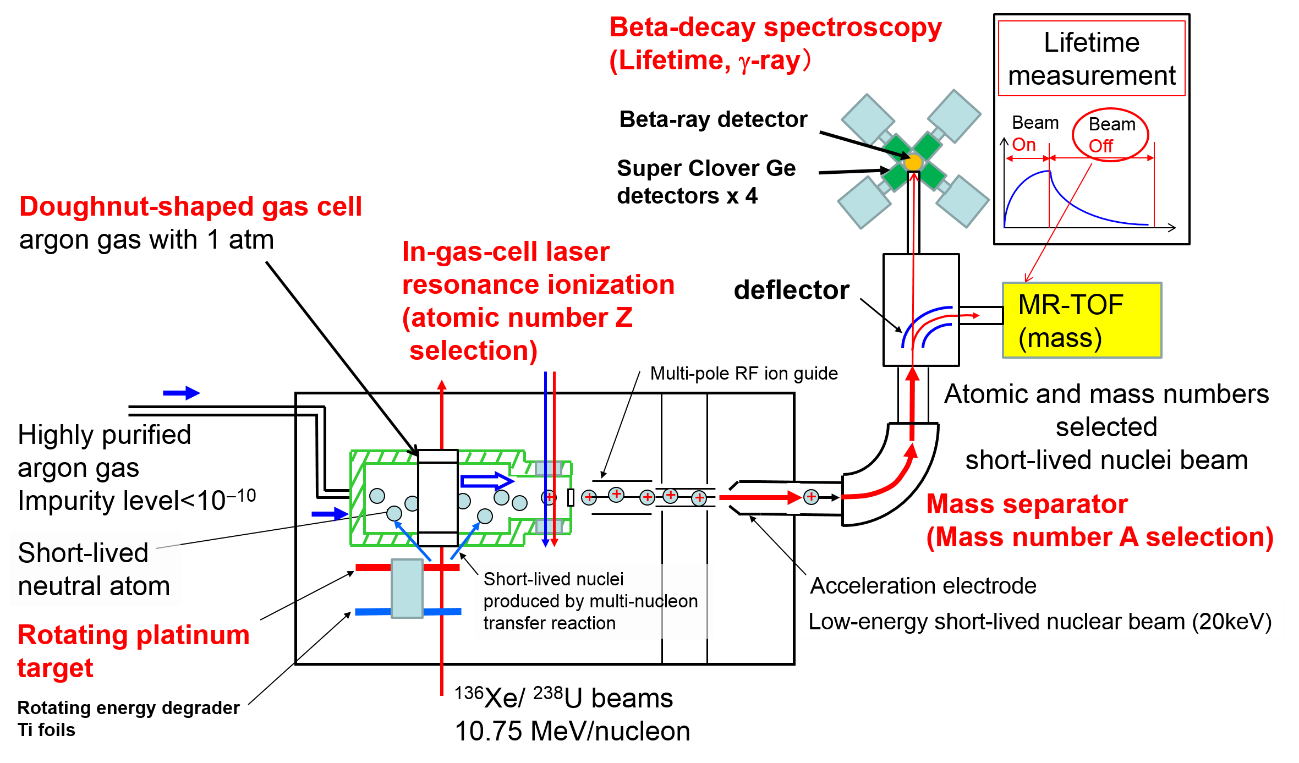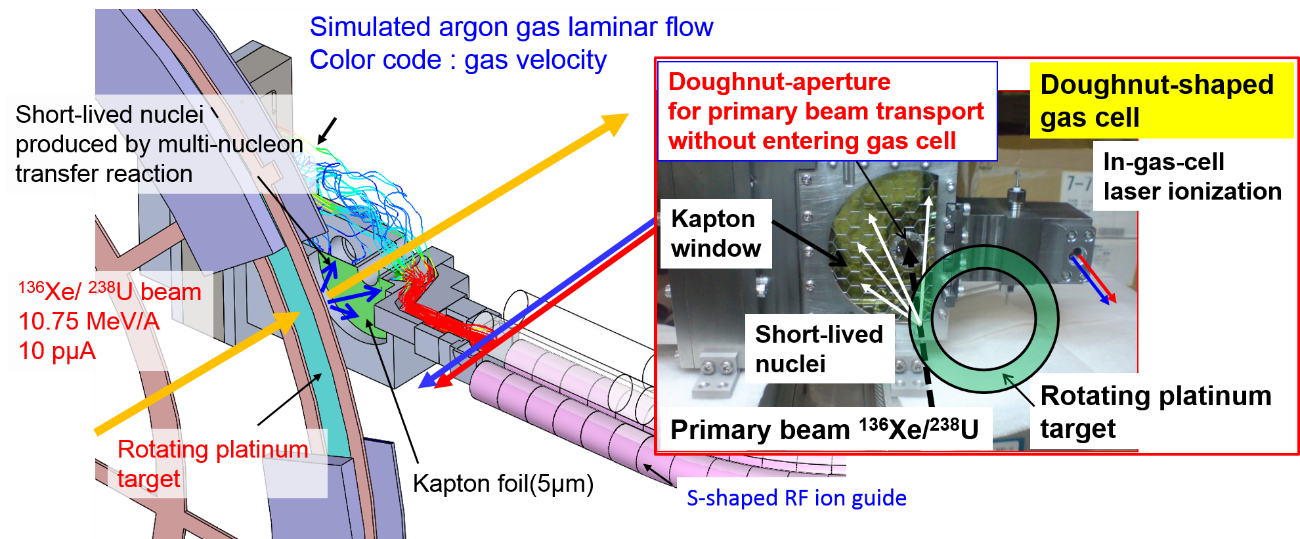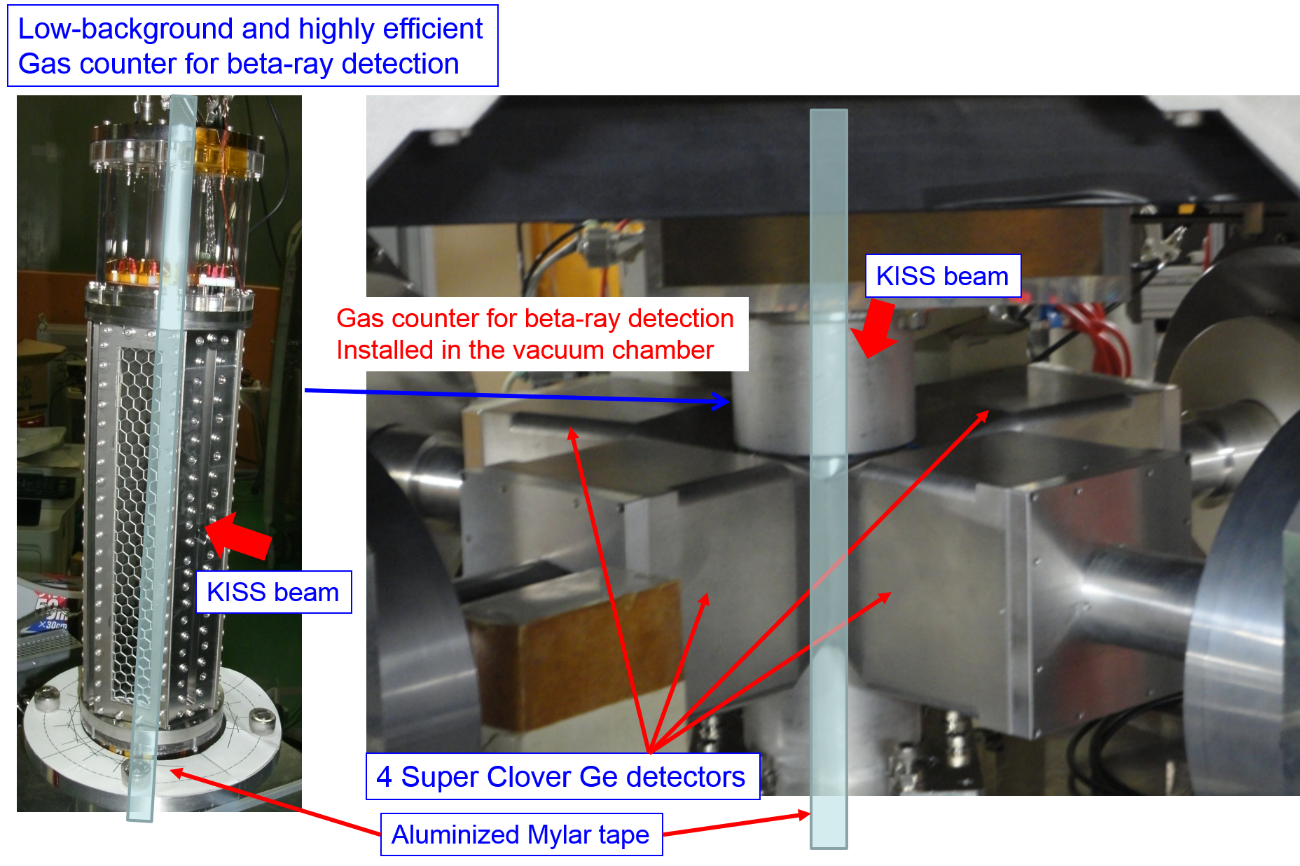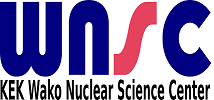Research background
Element selective isotope separation system : KISS (KEK Isotope Separation System)

We have studies the neutron-rich nuclei around N=126 by using the various nuclear spectroscopic techniques with the combination of the MNT reaction and the KISS.
Contents of our research
Multi-nucleon transfer (MNT) reaction
Production cross-section of short-lived nuclei around A~195 by using projectile fragmentation method with 238U beam is not so high (order of pb), therefore, new method for the production has been desired. We noticed the feasibility of MNT reaction using heavy ion beam with ~10 MeV/nucleon. In the collision between heavy nuclei with the lower-energy than Fermi-energy, many nucleons are supposed to be exchanged, and finally the transfer of neutrons and protons would be promoted. Due to the complex many-nucleon-transfer reaction mechanism, the theoretical models, which can predict the production cross-sections, have not been established. Therefore, it is desirable to verify theoretical prediction ability of the production cross-section experimentally.
By using VAMOS++ spectrometer at GANIL, we performed the systematic production cross-section measurement of the projectile-like fragments produced by the MNT reaction of 136Xe beam and 198Pt target system on March 2012. From the result, we ascertained that it is feasible to produce the nuclei around N=126 by using the MNT reaction. Moreover, we find out that if we use the 238U beam as the primary beam, the production cross-section would increase by a factor of more than 10. Now, we have started to study the production yields by using 238U beam.
Selection method of short-lived nucleus:argon gas cell + laser resonance ionization
Figure 1 shows the schematic view of KISS. Primary beam passes through the rotating energy degraders and then irradiates the rotating platinum-198 target for the production of the nuclei around N=126 by using MNT reaction. Produced short-lived nuclei are implanted into an argon gas cell, then are neutralized with the collision of argon, and are transported to the gas cell exit by argon gas laminar flow. The element with our interest is selectively ionized by using laser resonance ionization technique (atomic number Z selection). The ionized atoms are extracted as the KISS beam with the energy of 20 kV. The mass number A is selected by the rigidity of a dipole magnet. Finally, we can select only one kind of nucleus and transport it to the detector station for precise nuclear spectroscopy.

Fig.1 : Schematic view of KISS.
Short-lived nuclei produced by the MNT reaction are emitted from the platinum-198 target with large emission angles of ~65±10 deg. and low energy of 0~2 MeV/nucleon. Therefore, it is difficult to identify the nucleus by using the traditional method. In order to overcome the situation and to accumulate the reaction products with high efficiency, we developed the highly-purified argon gas cell with the pressure of 1 atm. The nuclei are stopped in the argon gas with a few cm thickness, neutralized and transported to the gas cell exit by argon gas laminar flow in ~0.5 s. We optimized the design of the gas cell in order to accumulate and transport the nuclei with high efficiency by using fluid dynamical simulation. We compared the gas transport time between the simulation and the experimental result, and the experimental result was in good agreement with the simulation successfully.
We apply two-color two-step laser resonance ionization method at the KISS. First laser with the wavelength around 250 nm excites an electron in the atom to an atomic intermediate state, and second laser transits the electron to an atomic level above an ionization potential, and then we can ionize the atom with our interest by changing the wavelength of first laser. In order to change the wavelength in the wide range of 200-1100 nm, we use a dye laser for the first laser and can ionize about 80% of the elements. For the second laser, we use intense excimer : XeCl (308 nm) laser as the ionization laser. By using this laser combination, we established the laser resonance ionization schemes for the heavy elements (Z=73-78).
Doughnut-shaped gas cell and rotating target
Figure 2 shows the developed doughnut-shaped gas cell and rotating target system in order to increase the production yield of short-lived nuclei with increasing the primary beam intensity.

Fig.2:Schematic view of new gas cell system and photo of doughnut-shaped gas cell.
Energy deposit in the target and energy degraders in the case of intense primary beam heats up the platinum target and titanium energy degraders, and finally melts them. We applied the rotating target and degraders to disperse the heat in them and to reduce the thermal damage. As the result, we can use 10 times higher beam intensity and increased the production yield by a factor of about 10.
Dense argon plasma in the gas cell induced by the intense primary beam produces UV light and X-rays. There radiations are considered to prevent the laser ionization and reduce the extraction efficiency from the gas cell. In order to reduce the plasma density drastically, we developed the doughnut-shaped gas cell where the primary beam do not enter the gas cell, and can increase the production yield of short-lived nuclei by a factor of ~10 by increasing the primary beam intensity. We have perform the R&D work to increase the production yield to access more neutron-rich nuclei.
Detector system for precise beta-decay spectroscopy
Figure 3 shows the detectors installed at KISS for beta-decay and gamma-ray spectroscopy. The KISS beam from the gas cell is implanted into an aluminized Mylar tape, and then we perform the decay spectroscopy from the measured decay-energy and decay-time by detecting the beta- and gamma-rays emitted after the beta-decay.
We have developed the 32 channel segmented proportional gas-counter for beta-decay spectroscopy of radioactive isotopes extracted from the KISS. Cylindrically aligned 16 set of 2-layered gas-counter telescopes can reduce background events of cosmic-rays and Compton scattering by analyzing the hit pattern of the counters. The counter gas is argon gas (90%) and methane gas (10%) with the pressure of 1 atm. Intrinsic detection efficiency of each telescope and solid angle are 95(2)% and 80% of 4, respectively. A low-background rate of 0.1 cps was achieved. In order to reduce the background rate down to 0.01 cps, we plan to develop the 3D tracking gas-counter by reading out the signals from the both ends of the anode wire.
4 Super Clover Ge (SCGe) detectors were installed by surrounding the gas-counter as shown in Fig. 3. The detectors were shipped from the IBS (Institute of Basic Science) in Republic of Korea under the collaborative work with KEK-WNSC. The main feature of the SCGe is the high detection efficiency. The SCGe consists of four large Ge crystals with the relative efficiency of 38%, and the absolute efficiency is about 20% for the gamma-ray with the energy of ~200 keV. We can increase the efficiency more than one order of magnitude. We have developed the data acquisition system which is specialized for analysis of gamma-ray signals under the collaboration。The system was applied from the experiments on Feb. 2017.
Now we have just started to perform the nuclear spectroscopy of the nuclei around N=126 at KISS.
Fig.3:Detectors installed at KISS for beta-decay and gamma-ray spectroscopy

Presentation/Meeting
International workshop/conference
- OMEG2015 2015/6/24-24, Y. Hirayama (Poster)
- EMIS2015 2015/5/11-15, Y. Hirayama (Oral), Y.X. Watanabe (Oral), S. Kimura (Poster), M. Mukai (Poster)
- ARIS2014 2014/6/1-6, Y. Hirayama (Poster), M. Mukai (Poster)
- 16th ASRC International Workshop 2014/3/18-20, Y.X. Watanabe (Oral)
- FUSION14 2014/2/24-28, Y.X. Watanabe (Invited)
- KEK-TRIUMF workshop 2013/10/10,11, H. Miyatake (Invited)
- LIA worhshop, 2013/9/30-10/4 Y.X. Watanabe (Invited)
- 12th Asia Pacific Physics Conference of AAPPS,
"Study of the multi-nucleon transfer reactions of 136Xe+198Pt for producing exotic heavy nuclei", Kim Young Hee (Oral) - INPC2013 Y. Hirayama (Poster), Y.H. Kim (Poster)
- EMIS2012 Y. Hirayama (Oral)
- "Beta-decay spectroscopy of r-process nuclei using KEK isotope separation system" by Y. Hirayama (Oral) at Advances in Radioactive Isotope Science - ARIS 2011 2011/5/29-6/3
- "KEK isotope separation system for β-decay spectroscopy of r-process nuclei" by Y.X. Watanabe (Oral)2nd IRiSworkshop
Domestic workshop/meeting
- 2016 SSRI-PNS Collaboration Meeting 2016/9/2-3
- SSRI-PNS Collaboration Meeting 2015/9/3-4
- The 2nd KISS workshop 2011/3/5
- The first KISS workshop 2010/9/6

